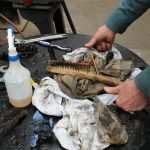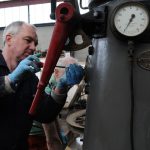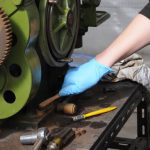Industrial Object Conservation Training
STICK obtained generous funding from the Museums Galleries Scotland Skills Development Fund to deliver a three day industrial object conservation training course.

Background
In 2014 Industrial Museums Scotland in collaboration with the Scottish Transport and Industrial Collections Knowledge network (STICK) and with funding from MGS, produced a paper entitled The Collection, Curatorship and Conservation of Large Objects. The popularity of this paper and conversations surrounding it highlighted the desire for more formal training on the subject.
As a result of discussions surrounding the above piece of work, the STICK network carried out a skills audit among its membership. 91% of respondents to the audit indicated that they care for industrial collections while only 45% have access to expert advice on their conservation. Of these 45%, several indicated that the support they had was limited and was through a network of colleagues, that it was through an external contractor and therefore limited through funding, or that it was through volunteers with engineering skills, rather than conservation professionals. 82% felt that engineering conservation training would help them progress the aims of their organisation.
The audit highlighted a lack of professional expertise among the staff of museums caring for industrial collections and a lack of ability to access professional advice. The most popular specific areas in which respondents indicated that they needed training and support were:
- Understanding how the parts are made and finished (Manufacture)
- The use of hand tools and traditional techniques in making parts (Skills)
- 3D thinking (The ability to imagine a machine as an assembly of parts)
- The importance of clearances and alignment within a machine (Measurement)
- The use of lubricants and cleaning & protecting /surface finishes (Ongoing Care)
Respondents also indicated a need for training in assessing risk, recording conservation processes and conservation ethos.
STICK met some of the needs highlighted by providing a three day training course in the care and conservation of industrial museum collections, ranging from hand tools to locomotives. This “up skilled” museum staff and volunteers and gave the confidence to curators to oversee and manage conservation projects in the knowledge that they have been carried out to appropriate standards and recorded and managed correctly.
The course was be the first step towards a larger contribution from STICK and partners to the care and conservation of Scotland’s industrial collections.
The course
This was hosted at National Mining Museum Scotland in early April 2017. The course was aimed at non-specialist museum staff and volunteers who have been tasked with caring for industrial collections with complex needs, and who do not have routine access to conservators and conservation resources. The aim was to upskill and give confidence to these individuals to enable them to better care for their collections and have confidence in managing and documenting preventative conservation projects in their organisations.
Twelve participants from organisations across Scotland took part in the course, which was delivered by Jim Mitchell of Industrial Heritage Consulting Ltd.. Some of the time was in the classroom discussing what conservation means, ethics, hazards, safety and techniques, among other topics. However, the majority of the course was spent in National Mining Museum Scotland’s large object store where the group got hands on with seven different items from the collection, applying learning directly, receiving direction from Jim and documenting their work on paper and through photographs and films.
Resources
Presentation: Industrial Object Conservation
Template: general conservation assessment
Template: conservation record sheet
Recording learning
- Jim talks to the attendees.
- WD40 was a key tool.
- Note the WD40 and wire brushes – not to mention rags. Key tools!
- More WD40 in use!
- Paperwork was illustrated as a key part of the process.
- Paperwork in action.
- Cleaning the wooden parts of a bogie.
- Cleaning the metal parts of a bogie.
- Team discussions.
- Working on winding engine controller.
- Working on winding engine controller.
- Work on cleaning up the lilly controller.
- Lilly controller work in progress.
- Lilly controller work in progress.
As part of the course, attendees were asked to talk about the project they had been working on, plus some key skills and tasks highlighted in these clips.
Follow up: recognising materials
During the course, Jim spoke off-the-cuff about how to recognise a variety of materials – mostly metal. As a result, STICK ran a follow up webinar with Jim speaking at length about how to recognise engineering materials used in or on conserved objects. You can view the webinar here.
Useful links
Useful Organisations
The Association of British Transport and Engineering Museums
Other Useful Resources
The Collection, Curatorship and Conservation of Large Objects
Social History Curators Group Object Lessons
Participating Organisations
National Mining Museum Scotland
Summerlee Museum of Scottish Industrial Life
Robert Smail’s Printing Works (National Trust for Scotland)
Scottish Railway Preservation Society
Ferryhill Railway Heritage Trust




















